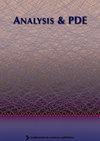Uniqueness of excited states to −Δu + u−u3 = 0 in three dimensions
IF 1.9
1区 数学
Q1 MATHEMATICS
引用次数: 0
Abstract
We prove the uniqueness of several excited states to the ODE , , and , for the model nonlinearity . The -th excited state is a solution with exactly zeros and which tends to as . These represent all smooth radial nonzero solutions to the PDE in . We interpret the ODE as a damped oscillator governed by a double-well potential, and the result is proved via rigorous numerical analysis of the energy and variation of the solutions. More specifically, the problem of uniqueness can be formulated entirely in terms of inequalities on the solutions and their variation, and these inequalities can be verified numerically.
三维激发态对-Δu + u-u3 = 0的唯一性
我们证明了模型非线性 f(y)= y3-y 的 ODE ÿ(t)+(2∕t)ẏ(t)+f(y(t))=0、y(0)=b 和ẏ(0)=0 的几个激发态的唯一性。第 n 个激发态是一个恰好有 n 个零的解,随着 t→∞ 趋于 0。这些表示 H1 中 PDE Δu+f(u)= 0 的所有光滑径向非零解。我们将该 ODE 解释为受双井势能支配的阻尼振荡器,并通过对解的能量和变化进行严格的数值分析来证明结果。更具体地说,唯一性问题完全可以用解及其变化的不等式来表述,而且这些不等式可以用数值来验证。
本文章由计算机程序翻译,如有差异,请以英文原文为准。
求助全文
约1分钟内获得全文
求助全文
来源期刊

Analysis & PDE
MATHEMATICS, APPLIED-MATHEMATICS
CiteScore
3.80
自引率
0.00%
发文量
38
审稿时长
6 months
期刊介绍:
APDE aims to be the leading specialized scholarly publication in mathematical analysis. The full editorial board votes on all articles, accounting for the journal’s exceptionally high standard and ensuring its broad profile.
 求助内容:
求助内容: 应助结果提醒方式:
应助结果提醒方式:


